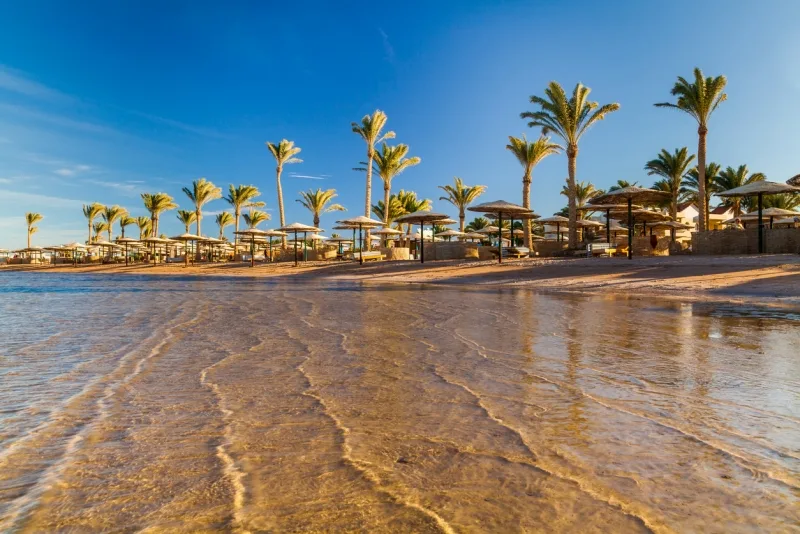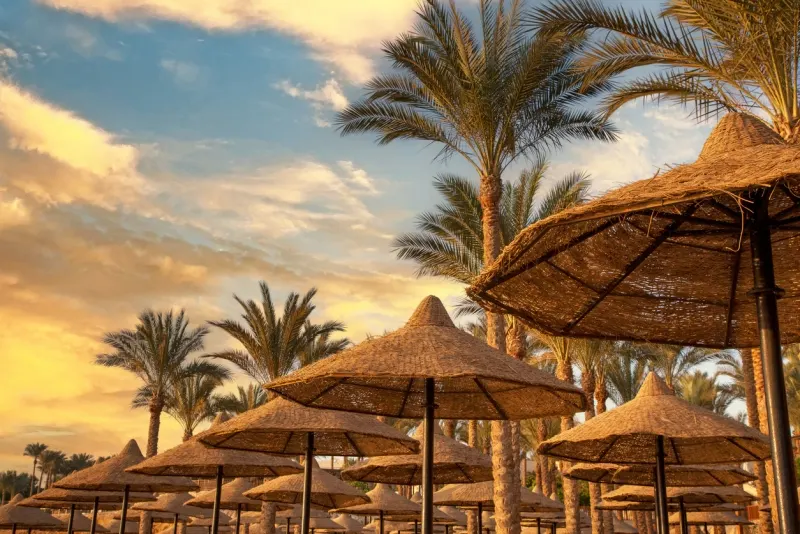Egypt Weather & Climate

Egypt’s climate is dominated by extreme heat and sunshine, with only two distinct seasons: a long, hot summer and a mild winter. Rainfall is scarce, limited mainly to the Mediterranean coast (100–200 mm annually), while Cairo receives just 25–50 mm and southern regions may go years without rain. This scarcity explains why 99% of the population lives in the fertile Nile Valley, which covers only 5.5% of the country’s land. Cities like Aswan and Luxor record some of the nation’s highest temperatures, often exceeding 30°C (86°F). Awareness of these conditions helps visitors prepare for a safe and comfortable trip.
Egypt Weather & Climate by Region
Egypt’s climate is hot and dry due to its desert landscape, with summers from May to September reaching up to 40°C. Weather varies between northern and southern regions, shaping travel experiences across the country.
1. Cairo: Urban heat and seasonal winds
Cairo has a hot desert climate intensified by urban heat, with summer nights warmer than nearby areas and a rare “cool island” effect by day. Summer averages 30–35°C with high humidity from the Nile Delta, while winters are mild at 18–25°C. Between March and June, the Khamsin wind brings extreme heat up to 49–50°C and very low humidity.
2. Alexandria: Coastal breezes and winter rain
Alexandria has a Mediterranean climate with 100–200 mm of annual rainfall, mostly in winter, peaking in January. Temperatures stay mild, from 13.8°C in January to 27.7°C in August, with sea breezes easing summer heat. Rising Mediterranean sea levels, about 1.5 mm yearly, pose growing climate challenges.
3. Aswan: Extreme heat and dry air
Aswan sits in southern Egypt and faces some of the country's most extreme weather. Summer heat climbs above 40°C between May and October. July burns hottest with average temperatures of 107°F/41.7°C. Winter offers slight relief as January temperatures average 16.5°C.
This city ranks among the world's driest and sunniest places. It barely sees rain with just 1.4 millimeters yearly. The sun shines for about 3,865 hours each year. The extreme dry conditions create big temperature swings between day and night. Winter nights can get quite cold, dropping below 10°C.

Seasonal Weather Patterns Tourists Should Know
Tourists make critical packing and planning mistakes because they don't understand Egypt's seasonal climate patterns. A good grasp of these patterns can transform an uncomfortable ordeal into a memorable experience.
1. Summer highs and how to cope
Egyptian summers (June through September) bring intense heat that catches visitors off guard. Upper Egypt sees temperatures above 40°C (104°F). Luxor and Aswan can reach scorching peaks of 45-50°C (113-122°F). Cairo's temperatures stay around 35°C (95°F), and the city's urban environment makes it feel even hotter.
Survival strategies include:
- Dawn activities work best for photography
- Indoor breaks between 11 AM and 4 PM
- Light-colored linen clothes and hand fans help
- Rehydration sachets and frozen electrolyte drink cubes provide relief
2. Winter lows and unexpected chills
Egypt's winters (December to February) surprise tourists with genuinely cold conditions. Cairo's daytime temperatures stay mild at 18-20°C (64-68°F), but nights can cool down to 9-11°C (48-52°F). Alexandria gets winter rainfall reaching 70 millimeters in January.
Egyptian homes have no central heating, which makes indoor spaces feel cold. People use heated air-conditioning, oil or electric heaters, and bundle up in coats, scarves and gloves. Swimming pools become too cold for comfort, though Red Sea waters stay warmer.
3. Spring and fall transitions
Spring and autumn give tourists the best balance of weather comfort and crowd levels. October temperatures drop to around 28°C (82°F). March and April provide comfortable weather for exploration before summer heat kicks in.
These seasons come with their challenges. The Khamsin winds blow between March and June. These hot, dry, sand-filled gusts can drive temperatures up while dropping humidity below 5%. They might last several days.
Fall months (September-November) bring cooler temperatures and moderate humidity. This makes it an ideal time to visit historical sites without summer crowds or winter rains.

How to Prepare for Egypt’s Climate
Egypt's distinctive climate needs careful planning beyond typical vacation packing. The country's extreme temperatures and unique weather patterns just need specific preparations to keep you comfortable and safe throughout your trip.
1. Acclimatization tips for new visitors
Your body needs time to adapt to Egypt's heat. You should schedule lighter activities at the time of your first 48 hours. This helps your body adjust to the new climate. Staying hydrated is crucial - take small sips frequently instead of drinking large amounts at once.
Smart timing of activities makes a big difference. Early mornings and evenings are perfect to explore comfortably. Take breaks indoors or find shaded spots during midday, especially when you have peak sun between 11 AM and 3 PM.
2. Clothing and gear recommendations
Cotton or linen clothes that fit loosely work best in Egypt's heat. Desert areas need layered clothing because temperatures drop a lot after sunset.
Essential gear has:
- Wide-brimmed hats and UV-blocking sunglasses
- Reusable water bottles with built-in filters
- Portable battery-powered fans
- High-SPF, water-resistant sunscreen
- Light scarves that protect your face and neck in dusty conditions
3. Staying safe during extreme weather
Only when we are willing to respect Egypt's climate can we spot warning signs of heat-related illness. Watch out for headaches, dizziness, and fatigue. These symptoms mean you should find shade right away and cool down with damp cloths on pulse points.
Khamsin winds mean staying indoors when possible. Use face masks if you must go outside. On top of that, it helps to check weather forecasts daily. Flash floods can develop faster in desert regions during rare rain events.
The best time for your trip to Egypt is between October and April. During these cooler months, daytime temperatures usually range between 18°C and 25°C, which makes sightseeing in places like Cairo, Luxor, and Aswan much more comfortable. If you’re planning a Nile cruise, exploring the Pyramids of Giza, or walking through the Valley of the Kings, this season is ideal. Winter (December–February) is especially pleasant along the Nile Valley and the Red Sea coast, where you can enjoy mild sunshine without the intense summer heat.
If you’re visiting Egypt between June and September, be prepared for very high temperatures. In Luxor and Aswan, the mercury often rises above 40°C (104°F). Even in Cairo, summer days average around 35°C (95°F), and the urban heat can make it feel even hotter. The Red Sea Riviera (Hurghada, Sharm El Sheikh) can also be scorching but is often more bearable thanks to the coastal breeze. To stay comfortable, plan outdoor activities for the early morning or evening hours, and reserve midday for shaded rest, indoor museums, or relaxing by the pool.
Rain is rarely an issue when you travel to Egypt, as the country is one of the driest on Earth. In southern areas like Aswan, rainfall is almost non-existent—sometimes years pass without a single drop. However, if you’re visiting Alexandria or the Mediterranean coast during winter, expect some occasional showers (100–200 mm annually). In central Egypt and the Nile Valley, rain is extremely rare, so your sightseeing around Luxor or Giza is unlikely to be interrupted.
When packing for Egypt, think lightweight, breathable clothing made from cotton or linen. A wide-brimmed hat, UV-protective sunglasses, and high-SPF sunscreen are must-haves, especially if you’re exploring sunny sites like the Pyramids of Giza or Abu Simbel. Desert nights in areas like the White Desert or Siwa Oasis can get chilly, so bring a few layers. Comfortable walking shoes are essential for exploring temples and tombs in Luxor and Karnak, and don’t forget a reusable water bottle to stay hydrated.
Yes, Egypt does have some unique weather patterns. Between March and June, you might experience the Khamsin winds—hot, dry, and dusty gusts that can raise temperatures suddenly and reduce visibility, especially in Cairo and the Nile Valley. While rare, flash floods can occur in desert areas along the Red Sea coast, particularly near wadis (dry riverbeds). If you’re traveling during these seasons, just keep an eye on local forecasts and follow your guide’s advice.
Customize Your Dream Vacation!
Get in touch with our local experts for an unforgettable journey.
Plan Your Trip
Unique Weather Events in Egypt
Egypt’s weather includes unique events like the khamsin, a hot sandy wind that can raise temperatures by up to 20°C. Such phenomena go beyond normal seasonal changes, shaping the land and daily life while surprising visitors and intriguing meteorologists.
1. The Khamsin wind phenomenon
The Khamsin stands out as Egypt's most dramatic weather event. This hot, dry, sand-filled wind gets its name from the Arabic word for "fifty," which refers to the roughly fifty-day period when it occurs. These winds usually show up between March and May, though they can appear as early as March or as late as June.
The Khamsin winds start from low-pressure systems that move east across the Sahara. They can reach speeds of up to 140 kilometers per hour. These powerful winds create some extreme conditions:
- Temperatures jump by 20°C in just two hours
- Relative humidity drops below 5%
- Sand and dust in the air severely reduce visibility
- The winds create electrical disturbances that make compasses unreliable
The Khamsin has altered the course of major military campaigns. It affected Napoleon's Egyptian expedition and disrupted Allied-German operations during World War II. Today, these winds disrupt travel, damage buildings, and cause breathing problems.
2. Flash floods in desert areas
Egypt is one of the world’s driest countries, yet sudden rainstorms can trigger flash floods, especially along the Red Sea coast and Eastern Desert. These rare but intense events, like Hurghada’s 2016 flood, cause damage to towns, infrastructure, and marine life. Limited data and few rain gauges make it difficult for scientists to fully understand or predict these floods.
3. Fog and mist in the Nile Valley
Although Egypt is known for sunshine, thick fog often blankets the Nile Delta in fall and winter, especially around Borg El Arab Airport near Alexandria. Fog forms on calm, humid mornings at 10–15°C, disrupting travel but also offering potential for fog-harvesting technology as a new water source.










